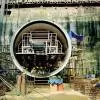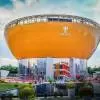Another Brick in the Wall
01 Jan 2012
8 Min Read
Editorial Team
In the next in a series of features showcasing building materials, Soumitro Ghosh, Principal Architect, Mathew & Ghosh Architects Pvt Ltd, elaborates upon the use of bricks by the Indian construction industry.
In an interview, Wolfgang Reithofer, CEO of Wienerberger AG - the world's largest brick manufacturer - spoke of Indians as being 'brick-minded', in reference to the country's long history in brick-based architecture. Indeed, India may well be the birthplace of clay bricks. Ruins of the Indus Valley civilisation, excavated at Harappa and Mohenjodaro, show the widespread use of bricks, though digs at sites of contemporary great civilisations in Mesopotamia and Egypt have also unearthed bricks made of soil and straw and possibly sun-dried. A landmark ancient building in brick in India is the world's oldest residential university of Nalanda, dating back to 500 BC. By this time, bricks were routinely used in China as well. According to Soumitro Ghosh, Principal Architect, Mathew & Ghosh Architects Pvt Ltd, the Indian affinity for bricks persists even today, two-and-a-half millennia on. But, a sea change in the varieties of bricks available is spurring the use of competitors of the humble traditional clay brick. In conversation with Charu Bahri, Ghosh outlines contemporary perceptions of the brick as a building material and his thoughts for its future use. Excerpts....
Spoilt for choice
There are many more varieties of bricks available today than a decade ago. Notably, India has seen a shift from consuming traditional clay bricks made by the soft mud process to clay bricks made by the extruded process. Extruded bricks are lighter, harder, stronger, denser, and less porous, hence impervious to seepage, making for better building performance. Also, brick-making has progressed in recent decades from traditional manual processes, making use of the circular or oval-shaped continuous Bull's Trench Kiln (BTK), based on British engineer W Bull's late 19th century energy-efficient design. Modern brick kilns are controlled electronically, thus allowing consistent, evenly finished batches to be produced. Newer methods of production ensure that bricks are available round the year, though the lead times of suppliers vary. Earlier, it was practically impossible to find a source for bricks during the monsoon. Imported brands like Wienerberger AG have also entered the Indian market and added to the array on offer.
Bricks in the age of skyscrapers
Bricks can be solid, cellular or hollow. Nowadays, hollow bricks are growing more popular as they offer better thermal resistance and climate control and are easier to run plumbing and electrical conduits through. You don't need to chisel out the brick to create channels. The green building movement is helping to raise awareness of insulating materials like hollow bricks. Some architects and end-users who like the finish and appearance of hollow bricks do not plaster or paint surfaces.
Indian cities are seeing a greater number of taller structures being constructed that mandate walls made of lightweight, strong hollow bricks to reduce deadweight. Incidentally, skyscrapers are not particularly conducive to brick building, as is evident from historical fact. Britain saw the widespread use of brick and timber during the Industrial Revolution, and the parallel construction boom in the US made avid use of locally made bricks as well. As the trend turned towards tall buildings, the brick was swiftly cast aside in favour of iron and later steel and concrete. Early 'skyscrapers' made in masonry, such as the 17-storey Monadnock Building in Chicago dating back to 1896, demonstrated the drawbacks of brick. Bricks only made a comeback in tall building construction in the 1950s, after the Swiss Federal Institute of Technology and the Building Research Establishment in Watford, UK, came up with a method to build tall structures (18-storey structure) with bearing walls that were no thicker than a single brick. But, this potential has never been fully developed because other materials, notably concrete blocks, had appeared on the scene by then and were found to greatly facilitate the speedy construction of high-rise buildings.
Competitors of bricks
Concrete blocks are sometimes considered a kind of brick, although they are not, strictly speaking. Usually pale grey in colour, the blocks are made from dry, small aggregate-based concrete. Finished blocks are cured - rather than fired - using low-pressure steam. Concrete blocks are giving clay bricks stiff competition as they are produced in a much wider range of shapes and sizes and are available with a wider range of face treatments, some of which can simulate the rustic appearance of clay bricks. The most commonly made brick size in the country is the British Major (9' x 4.5' x 3'), although North India has an old tradition of using bricks that were barely 2' thick. Historically, bigger bricks were more insulating and hence used in colder climates, such as Russia. The British Major is handy and light enough to be picked up by the bricklayer using one hand, making for efficient laying. But, larger concrete blocks require less joints and hence mortar and handling, reducing the cost and increasing the speed of construction. Their larger, hollow interior cavities improve insulation with no loss of strength. The uptake of calcium silicate bricks composed of flyash and recycled concrete is also increasing, but they tend to be consumed near production centres and thermal power plants. Flyash bricks, as they are called, can be made in a variety of colours.
Brick influences on architecture
In the late 20th century, the use of bricks was confined to low or medium-rise structures or for internal non-load-bearing walls. The concept of brick dry cladding grew more popular; this consists of a thin decorative layer of brick clad over concrete and steel to give the façade a natural appearance that stands apart from modern aluminium façades. Besides traditional clay bricks, natural stone bricks made of granite, limestone, sandstone and marble are used as cladding material for their durability and distinct look. Otherwise, natural stone bricks are perceived as possessing limited utility because of their high weight, and consequent foundation needs and laying time. Sometimes, bricks are glazed using salt to lay an impervious or ornamental surface on the brick surface. They are chosen for their colour, surface texture, density, weight, absorption, thermal characteristics, thermal and moisture movement, and fire resistance.
A wider choice of materials means that architects must consider client material preferences at the outset of designing projects. Brick walls differ from concrete block walls in thickness, and this has an impact on structural design. Building material, especially bricks, has always influenced architecture. In the 12th century, Italian bricks were reintroduced (previously introduced by the Romans) to Germany, as a result of which a new tradition emerged. Brick Gothic, a simpler style of Gothic architecture wherein buildings are made almost exclusively of bricks, evolved and flourished in North Europe. A few centuries later, during the Renaissance and the Baroque periods, brickwork began to be plastered. Around the mid-18th century, brick walls began making a comeback, as seen in the Dutch Quarter of Potsdam. This material has faded in and out of favour with architects over time. But, I believe the traditional brick is a natural material that will never be completely cast aside. I foresee a bright future for bricks in spite of the competition presented by cheaper, more durable, and easier to use (especially for large residential and commercial projects) concrete blocks. Perhaps, my positive sentiments are because Indians are brick-minded?
Brick jaalis and more
Laurence (Laurie) Wilfred Baker, renowned British-born Indian architect and humanitarian, came to India in the 1940s after meeting Mahatma Gandhi and being convinced to take up the position of Chief Architect for the Mission to Lepers, to build leper homes across India. Jaalis (perforated screens) made of bricks are amongst the well-known elements defining Baker's intrinsic style of architecture. Patterned brick jaalis replaced glass windows, frames and sills in Baker-designed buildings, catching light and air and diffusing glare, while ensuring privacy and security. As any kind of window is more expensive to construct than a wall by at least 30 times, these nifty features helped Baker build cost-effective environment-friendly structures, decades before 'green' became a buzzword of the construction industry. Interestingly, the construction of such ventilation mandates no special materials or skills.
Most bricks are twice as long as they are wide to allow them to be laid bonded to increase structure stability and strength. But, Baker devised different bonding techniques for bricks, which allowed him to build half-brick thickness. To add rigidity, he sometimes designed walls in a stepped or curved form. Baker's brick walls were always exposed; this is his reasoning: "Bricks to me are like faces. All of them are made of burnt mud, but they vary slightly in shape and colour. I think these small variations give tremendous character to a wall made of thousands of bricks, so I never dream of covering such a unique and characterful creation with plaster, which is mainly dull and characterless. I like the contrast of textures of brick, of stone, of concrete, of wood."
Baker made spanned openings in brick walls economical by using a 'stepped' or 'corbelled' arch. That is, bricks on each course are cantilevered out a few inches beyond the lower course until the required span is achieved. Reinforced brickwork is used for rectangular openings, which make the most of the composite action of the lintel with the masonry above.
To share your experience with any construction material, write in at feedback@ASAPPmedia.com

















